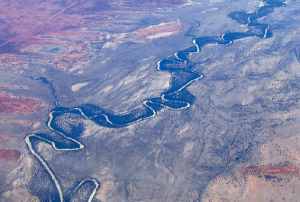– By Graham Quint, Director, Conservation
 ABC News recently reported on a NASA led study into the melting of the Western Antarctica Thwaites Glacier, which is twice the size of Tasmania. Scientists have estimated that up to 14 billion tonnes of ice have melted in the past three years leaving a cavity beneath the glacier two-thirds the size of New York’s Manhattan and more than 300 metres tall. Is this an extreme weather event, part of a naturally recurring cycle, or is it evidence of global climate change?
ABC News recently reported on a NASA led study into the melting of the Western Antarctica Thwaites Glacier, which is twice the size of Tasmania. Scientists have estimated that up to 14 billion tonnes of ice have melted in the past three years leaving a cavity beneath the glacier two-thirds the size of New York’s Manhattan and more than 300 metres tall. Is this an extreme weather event, part of a naturally recurring cycle, or is it evidence of global climate change?
In January, 2019 the annual Worldwide Threat Assessment of the United States Intelligence Community was presented to the Senate Select Committee on Intelligence. The Assessment outlined the impacts of climate change and poor governance practices increasing water and food insecurity around the world. So it does appear that the US Office of the Director of National Intelligence is taking the impacts of climate change very seriously, notwithstanding political pronouncements to the contrary.
And what of Australia, the world’s driest continent after Antarctica?
In Australia, inland water systems differ markedly from rivers in other parts of the world. While most rivers in the Northern Hemisphere and many other parts of the world are replenished annually by major snow melts, only rivers in the Australian Alps function in this manner. Australia’s greatest river system, the Murray Darling, has limited water input as it relies on runoff which is being captured and withheld, while simultaneously it is subject to major water extraction. River and groundwater conservation policy has become urgent with scientific evidence of major and possibly catastrophic climatic changes in the future.
On 29 January, 2019, the Murray-Darling Basin Royal Commission Report was presented. This was very timely in the light of the massive fish kill in the Menindee Lakes, which had occurred only two weeks earlier.
The Royal Commission Report concluded that the Murray Darling Basin Authority “is required to take into account climate change to accord with Australia’s international obligations, satisfy the principles of Ecologically Sustainable Development and to meet the requirement to draft the Basin Plan and exercise its other functions based on the best available scientific knowledge.” The Report noted that “Chapter 4 of the Basin Plan (Identification and management of risks to Basin water resources), as currently made, does not come close to meeting these requirements.”
Where does the National Trust (NSW) stand?
The National Trust has long argued for the conservation of the heritage and ecological values of rivers and their catchments in New South Wales. In 1974 the Trust published “Regeneration of the Parramatta River and in 1976 conducted a symposium “Planning the Future of the Hawkesbury River Valley.” In the 1980s/90s the National Trust campaigned for the protection of the Sydney Metropolitan, Woronora and Warragamba Inner Catchment Areas.
Many NSW rivers and their valleys have been listed on the National Trust Register includes:
- Cox’s River (Hartley, Kanimbla & Megalong Valleys, 1986)
- the Hunter River Estuary (1976)
- the Snowy River (Kosciusko Alpine Areas, 1977)
- Lower Hawkesbury River (1988)
- Macquarie River (Macquarie Marshes 1985)
- Murray River (Murray Valley Flood Plain, 1975)
- Myall River (Myall Lakes, 1977)
- Parramatta and Lane Cove Rivers (1983)
- Gloucester, Avon & Wards Rivers (Stroud Gloucester Valley, 1976)
- Cataract, Cordeaux, Avon & Nepean Rivers (Woronora Plateau, 1988)
- Wolgan River, (Wolgan Valley, 1976)
- Georges River, (Gwawley Bay, 2004 & Kyle Bay, 2014)
- Jenolan River, (Jenolan Caves, 1985).
National Trust Register Listing Reports set out the historical, scenic, social, cultural and scientific values of these listed rivers and their catchments.

On 8 February, 2019, the Chief Judge of the NSW Land and Environment Court rejected a proposed open cut coal mine for coking-coal for steel-making saying that an open-cut coal mine “in this part of the Gloucester Valley would be in the wrong place at the wrong time.” It was the wrong place because of “this scenic and cultural landscape”. It was the wrong time “because the greenhouse gas emissions of the coal mine and its coal product will increase global total concentrations of greenhouse gases at a time when what is now urgently needed, in order to meet generally agreed climate targets, is a rapid and decrease in greenhouse gas emissions. These dire consequences should be avoided.”
The National Trust strongly endorses the view that the rivers of New South Wales their catchments, and the State’s groundwater systems have historic, scenic, social, cultural and scientific values; have long been recognised as “country” by the Aboriginal people; were highly valued by early settlers; and continue to be valued by current communities. We will continue to champion, through National Trust Register Listing, the values of the State’s rivers, catchments and groundwater systems and will strongly lobby for the protection of those values using conservation management best practices, supported by the participation of a well-informed community.
The Trust will pursue governments at all levels to act upon the irrefutable mounting evidence of the increasing and damaging impacts of climate change and its exacerbating effects on climate hazards such as extreme weather, higher temperatures, droughts, floods, bushfires, storms, sea level rise and soil degradation which threaten human populations, ecological communities, property and infrastructure, health, water and food security.
We will call for improved governance of rivers, catchments and groundwater systems to cope with the unpredictability of changes in frequency and variability of heatwaves, droughts and floods.
We will endeavour to be better informed so as to understand, recognise and able to respond meaningfully to the threats posed to Aboriginal communities’ culture, by the impacts of climate change and poor governance of our State’s rivers and catchments and we will seek to better identify the social, cultural, historic and industrial heritage values of smaller towns in regional NSW and the pressures that they now face through water supply uncertainties, climate hazards and the impacts of climate change.
The Trust will put increased emphasis on recognising the role and importance of groundwater systems and their scientific and historic values, and the need to ensure that they are not damaged or degraded.
What can you do about climate change?
- Pursue governments at all levels to act upon the irrefutable mounting evidence of the increasing and damaging impacts of climate change and its exacerbating effects on climate hazards such as extreme weather, higher temperatures, droughts, floods, bushfires, storms, sea level rise and soil degradation which threaten human populations, ecological communities, property and infrastructure, health, water and food security.
- Call for improved governance of rivers, catchments and groundwater systems to cope with the unpredictability of changes in frequency and variability of heatwaves, droughts and floods.
“Greenhouse gas emissions of the coal mine and its coal product will increase global total concentrations of greenhouse gases at a time when what is now urgently needed, in order to meet generally agreed climate targets, is a rapid and decrease in greenhouse gas emissions. These dire consequences should be avoided.”
Brian Preston, Chief Judge of the NSW Land & Environment Court, Rocky Hill Coal Project (Gloucester Valley) Appeal
